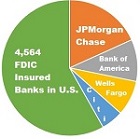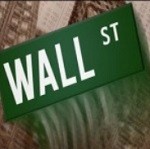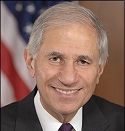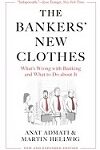-
Recent Posts
- Jamie Dimon’s Washington Post OpEd Gets Pummeled at Yahoo Finance
- In the Span of 72 Hours, Four People Tied to a Hewlett-Packard Criminal Case Died in Two Separate Events
- Crypto Took Down Another Federally-Insured Bank and Just Handed Its CEO a 24-Year Prison Sentence
- All the Devils from 2008 Are Back at the Megabanks: Leverage, Off-Balance-Sheet Debt, Over $192 Trillion in Derivatives, Shaky Capital Levels
- New Study Says the Fed Is Captured by Congress and White House — Not the Megabanks that Own the Fed Banks and Get Trillions in Bailouts
- Data from the Fed’s Emergency Funding Program Shows Spring 2023 Banking Crisis Was Far Deeper than Americans Were Told
- These FDIC-Insured Banks Have Lost 69 to 40 Percent of their Market Value Year-to-Date
- Exposure at Hedge Funds Has Skyrocketed to Over $28 Trillion; Goldman Sachs, Morgan Stanley and JPMorgan Are at Risk
- We Charted the Plunge and Rebound in the Nikkei Versus Nomura and Citigroup; the Correlation Is Frightening
- Former U.S. Labor Secretary Says Billionaires Have No Right to Exist Because their Wealth Comes from Five Illegal or Bad Practices
- Citigroup Is Having a Helluva Summer: A Protest on Thursday Will Turn Up the Heat
- Nikkei Has Biggest Drop in History: Here’s What’s Causing the Global Market Selloff
- JPMorgan Is Tapping Illiquid Assets in its Global Collateral Program; the New York Fed Is Paying for Its Services
- Bank Regulators Issue Warnings on Fintech and Banking as Disasters Pile Up
- Donald Trump Gives a Speech on Not Letting China Win the Crypto Race – Not Realizing China Banned Crypto Mining and Transactions Four Years Ago
- The New York Fed Has Contracted Out Key Functions to JPMorgan Chase; We Filed a FOIA and Got These Strange Invoices
- On the Eve of Netanyahu’s Address to Congress, Senator Bernie Sanders Delivers a Breathtaking Assessment of His War Crimes
- Trump’s Sit-Down with Netanyahu at Mar-a-Lago Will Cost U.S. Taxpayers Millions While Profiting Trump’s Business
- Protecting Trump and His Jet-Setting Adult Children During His Presidency Cost Taxpayers Over $1 Billion
- A Congressman and a Doctor Reported a Woman Being Shot at Trump Rally: She’s Vanished from Official Reports
- Jamie Dimon Goes Missing from Earnings Call, After Dumping $183 Million of His JPMorgan Chase Stock Earlier this Year
- U.S. Senate Candidate Backed by Hedge Fund Billionaires Was Sitting in Front Row at Trump Rally as the Sniper Fired into the Bleachers
- Project 2025: The Fossil Fuel and Banking Money Behind the Madness
- The Fund Created to Unwind a Failing Megabank Has a Problem: There’s No Money in It
- Joe Biden Versus the New York Times
- Grand Jury Transcript in Jeffrey Epstein Case Is Released, Raising Questions about Epstein’s Darkest Secrets Being Protected in JPMorgan Cases
- The Supreme Court Crowns a King, Immunizing Future Criminal Acts Under Project 2025 – a Right Wing Manifesto
- The Debate Disaster and the Supreme Court’s “Chevron” Repeal Have a Money Trail Leading to Charles Koch
- Congressman Andy Barr Stacks a Hearing on the Fed’s Stress Tests with Lobbyists for Megabanks
- The Fed Posts Historic Operating Losses As It Pays Out 5.40 Percent Interest to Banks
- Goldman Sachs’ Bank Derivatives Have Grown from $40 Trillion to $54 Trillion in Five Years; So How Did Its Credit Exposure Improve by 200 Percent?
- The Fed and FDIC Wake Up Suddenly to the Threat of Derivatives, Flunking the Four Largest Derivative Banks on their Wind-Down Plans
- Is the Stock Market Setting Investors Up for a Tech Bust Similar to the Dot.com Bust?
- Chase Bank Customers Are Reporting a Wave of Wire Fraud in their Accounts; the Bank Won’t Make Good on the Looted Funds
- The Senate Race in Ohio Is the Sickest in U.S. History in Terms of Billionaire Money from Outside the State
- Sullivan & Cromwell’s Legal Work for Sam Bankman-Fried’s Crypto House of Fraud Is Getting a Closer Look in Two Federal Court Cases
- Crypto Tries to Recreate the Koch Money Machine to Pack Congress with Shills
- French Fears Ignite Selloff in U.S. Megabanks and Foreign Peers
- Crypto Just Got Exponentially More Dangerous: Meet Fairshake
- Nvidia Hit a $3 Trillion Market Cap Last Week; Dark Pools Are Making Over 300,000 Trades in the Stock Weekly
- The Consumer Financial Protection Bureau Is Making Enemies in All the Right Places
- A Former Exec at Citibank Raises Alarm Bells in Federal Court Over Failed Risk Controls Inside the Bank
- Charles Koch’s Money Is Being Used in Elections in Ways Only Orwell Could Have Imagined
- Freakonomics and Frankenbanks: JPMorgan Chase Sucked Up 18 Percent of All Profits of 4,568 FDIC-Insured Banks in the First Quarter
- Academic Study Provides Hard Numbers to the Sick, Revolving Door Culture at Goldman Sachs, JPMorgan and Citigroup
- $244 Billion of Treasury Debt to Hit the Market Today and Tomorrow as Interest Rates Spike on Ballooning Supply
- CFTC Fines J.P. Morgan Securities — a Fed Primary Dealer — $100 Million for Failing to Surveil Potential Spoofing and High Frequency Trading for Eight Years
- Another FDIC-Insured Bank Got in Bed with Fintech; It’s Now Got a Dumpster Fire and Desperate Pleas from Customers for their Money
- Citigroup Gets Fined $79 Million Two Years After It Caused a $300 Billion Flash Crash in European Stock Markets
- After Weeks of Howling by MAGA Republicans for the Chair of the FDIC “to Resign,” a Democrat Delivers the Decisive Stab in the Back
Search Results for: Jamie Dimon
French Fears Ignite Selloff in U.S. Megabanks and Foreign Peers

By Pam Martens and Russ Martens: June 12, 2024 ~ Yesterday, The Hill published an OpEd by the man who, literally, wrote the book on the megabanks: Arthur E. Wilmarth, Jr., Professor Emeritus of Law at George Washington University Law School. Wilmarth raised critical points on why these megabanks continue to pose unacceptable levels of risk to U.S. financial stability and need to dramatically boost their equity capital – notwithstanding their fierce lobbying and propaganda battle to overturn the proposed new capital rules by bank regulators. The forces of the universe seemed to align with Wilmarth’s gutsy OpEd yesterday. In a display of just how dangerously interconnected with derivatives these megabanks remain, their share prices tanked in tandem yesterday despite the S&P 500 and Nasdaq indexes each setting a new record high. The contagion among the megabanks spread after French President Emmanuel Macron called snap parliamentary elections for June 30 and … Continue reading
Freakonomics and Frankenbanks: JPMorgan Chase Sucked Up 18 Percent of All Profits of 4,568 FDIC-Insured Banks in the First Quarter

By Pam Martens and Russ Martens: June 3, 2024 ~ Last Wednesday, the Federal Deposit Insurance Corporation (FDIC) released its quarterly banking profile for the quarter ending March 31, 2024. A key piece of data released at that time was the net income (net profits) for all 4,568 FDIC-insured banks in the United States. That tally came in at $64.2 billion. We decided to see just how concentrated those profits have become at a handful of behemoth banks on Wall Street – which also dangerously operate as trading casinos. We had no problem knowing where to start. We picked the largest and riskiest bank in the United States, JPMorgan Chase. The publicly-traded JPMorgan Chase & Co., which includes its sprawling trading operations around the globe as well as the FDIC-insured bank, had previously reported net income for the first quarter of $13.4 billion. A handy page at the FDIC, using the … Continue reading
Academic Study Provides Hard Numbers to the Sick, Revolving Door Culture at Goldman Sachs, JPMorgan and Citigroup

By Pam Martens and Russ Martens: May 30, 2024 ~ On January 18, 2019 the Cambridge University Press published a stunning research paper from the Journal of Institutional Economics. The paper provides the hard numbers to support the thesis that federal banking and securities regulators have arrived at a deep understanding and acceptance that the more connections they acquire while working in government and the more prominent their position becomes – the fatter their future paycheck will be once they make the leap to a megabank on Wall Street. The authors call what the “public servants” are selling to their prospective Wall Street employers “bureaucratic capital.” The authors then provide the hard data in the chart below, showing that Goldman Sachs, JPMorgan, and Citigroup are light years ahead of their peers in monetizing public service to fatten their own bottom lines and create an influence network. (The structure of that influence … Continue reading
CFTC Fines J.P. Morgan Securities — a Fed Primary Dealer — $100 Million for Failing to Surveil Potential Spoofing and High Frequency Trading for Eight Years

By Pam Martens and Russ Martens: May 28, 2024 ~ How does a Wall Street trading firm gain competitive advantage to entice spoofers and high-frequency trading firms to use its trading platforms instead of those of its competitors? How about having its trading compliance personnel wear a blindfold as billions of trades occur over the span of 8 or 9 years? That is essentially what three of JPMorgan Chase’s federal regulators have suggested is behind the $448 million in fines they’ve leveled against three separate units of the largest bank in the United States. When JPMorgan Chase filed its quarterly report with the Securities and Exchange Commission on May 1, it sheepishly admitted that the $348 million it had already paid out to two of its regulators for trading violations was not the end of this saga. It said that it “expects to enter into a resolution with a third U.S. … Continue reading
After Weeks of Howling by MAGA Republicans for the Chair of the FDIC “to Resign,” a Democrat Delivers the Decisive Stab in the Back

By Pam Martens and Russ Martens: May 21, 2024 ~ Yesterday, at 10:08 a.m., Senator Sherrod Brown, a Democrat from Ohio and the Chair of the Senate Banking Committee, sent out a shocking emailed statement to the press indicating that Brown was “calling on the President to immediately nominate a new Chair who can lead the FDIC at this challenging time and for the Senate to act on that nomination without delay.” By 6:27 p.m. the Associated Press was reporting that Martin Gruenberg would step down as Chair of the FDIC and President Joe Biden would announce his nomination to replace him “soon.” The Brown statement was a gut punch to every engaged American and journalist who actually understands what’s at stake here. It was not only a back stab to Gruenberg, it was a back stab to Brown’s highly-respected colleague on the Senate Banking Committee, Senator Elizabeth Warren, who has … Continue reading
Saudi Arabia’s Wealth Fund Dumps Its JPMorgan Chase Stock; Warren Buffett’s Berkshire Hathaway Did the Same in 2020

By Pam Martens and Russ Martens: May 16, 2024 ~ Foreign central banks and sovereign wealth funds are required under U.S. law to report their publicly-traded U.S. stock positions no later than 45 days after the end of each calendar quarter, if those stock holdings reach $100 million or more. This is done on Form 13F, which is filed with the Securities and Exchange Commission (SEC). Sophisticated traders, algorithms at the big trading houses on Wall Street, and giant hedge funds mine that data to spot bullish or bearish signals they might be able to trade on. Unfortunately, for reasons we haven’t been able to unleash from the tight grip of the SEC over many years, some of the central banks and sovereign wealth funds with massive holdings in U.S. stocks do not report their holdings, or, the SEC is granting them confidentiality. One sovereign wealth fund that has been reliably … Continue reading
One of Jeffrey Epstein’s Protectors at JPMorgan Chase, Mary Erdoes, Has Sold $29 Million of Her Stock in the Bank Since Just Before Epstein’s Arrest in 2019

By Pam Martens and Russ Martens: May 14, 2024 ~ In 2020, Netflix released a documentary series titled “Filthy Rich,” based on the book by the same name. The series examined how sex trafficker Jeffrey Epstein was able to continue to enjoy his wealth and power even after Palm Beach, Florida police had built a case that he had sexually-assaulted more than a dozen young girls – many from public schools in middle-class areas surrounding the mansions of Palm Beach. A sweetheart deal between the Florida State Attorney and the U.S. Department of Justice allowed Epstein to serve just 13 months in jail from June 2008 to July 2009, most of it in a work release program in which he was driven to an office daily by his chauffeured limousine. Epstein was allowed to be on the loose for another decade until the Department of Justice was embarrassed into arresting Epstein … Continue reading
Cleary Gottlieb – Outside Counsel to Wall Street’s Serially Bailed Out Megabanks – Tarnishes the FDIC Chair in its So-Called “Independent” Report

By Pam Martens and Russ Martens: May 8, 2024 ~ Yesterday, the Big Law firm Cleary Gottlieb released its so-called “independent review” of charges of sexual harassment at the Federal Deposit Insurance Corporation (FDIC). Although no employee is charging Martin Gruenberg, the Chair of the FDIC, with sexual harassment, Cleary Gottlieb seems to go out of its way to paint Gruenberg in a negative light in the report – 108 times in fact. Gruenberg held the deciding vote at the FDIC last July when the bank regulator approved moving forward with proposed new rules to significantly raise the capital levels at the megabanks on Wall Street, particularly those holding trillions of dollars in derivatives off their balance sheet. These include the same banks that secretly received $16 trillion in cumulative emergency loans from the Federal Reserve from December 2007 to July 2010 because they were undercapitalized and teetering on insolvency, as … Continue reading
JPMorgan Chase and Its Regulators Are Hiding Dark Trading Secrets at the Largest and Riskiest U.S. Bank

By Pam Martens and Russ Martens: May 7, 2024 ~ Last Wednesday, JPMorgan Chase, the publicly-traded parent of the largest federally-insured bank in the United States as well as a five-count felon, revealed in a filing with the Securities and Exchange Commission that on top of the $348 million it paid out in March to two of its banking regulators for sketchy trading violations involving “billions” of trades on 30 global trading venues, it “expects to enter into a resolution with a third U.S. regulator that will require the Firm to, among other things, pay a civil penalty of $100 million….” (See “Trading Venues Investigations” on page 168 of the SEC filing at this link.) JPMorgan Chase did not name this third regulator but Bloomberg News reported that it is the Commodity Futures Trading Commission. The two federal banking regulators that imposed the trading fines in March are the Office of the … Continue reading
Wall Street’s Megabanks Have Trillions of Dollars Off-Balance Sheet, in a Replay of Accounting Hubris that Led to the 2008 Wall Street Collapse

By Pam Martens and Russ Martens: May 2, 2024 ~ When the Financial Crisis Inquiry Commission released their final forensic report on the causes of the 2008 financial collapse on Wall Street – the worst collapse since the 1929-1932 collapse – it pointed to hidden leverage in off-balance sheet entities at the megabanks on Wall Street as a key driver of the crisis. It wrote: “From 2000 to 2007, large banks and thrifts generally had $16 to $22 in assets for each dollar of capital, for leverage ratios between 16:1 and 22:1. For some banks, leverage remained roughly constant. JP Morgan’s reported leverage was between 20:1 and 22:1. Wells Fargo’s generally ranged between 16:1 and 17:1. Other banks upped their leverage. Bank of America’s rose from 18:1 in 2000 to 27:1 in 2007. Citigroup’s increased from 18:1 to 22:1, then shot up to 32:1 by the end of 2007, when Citi … Continue reading

